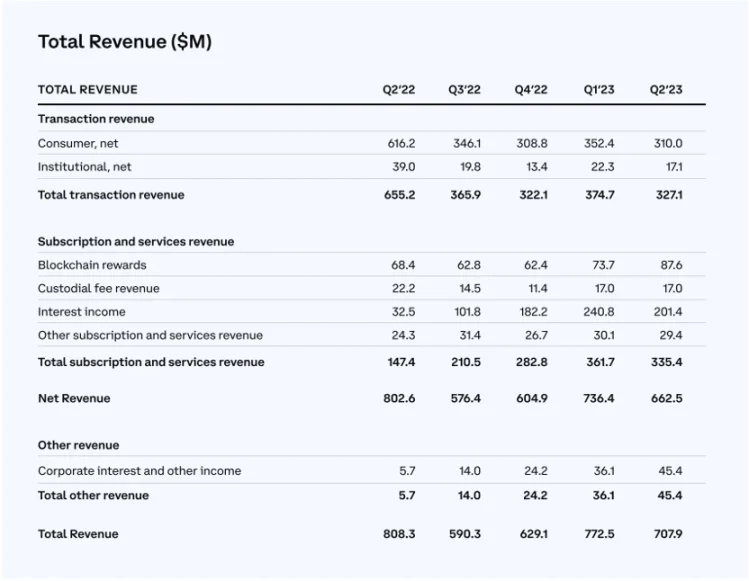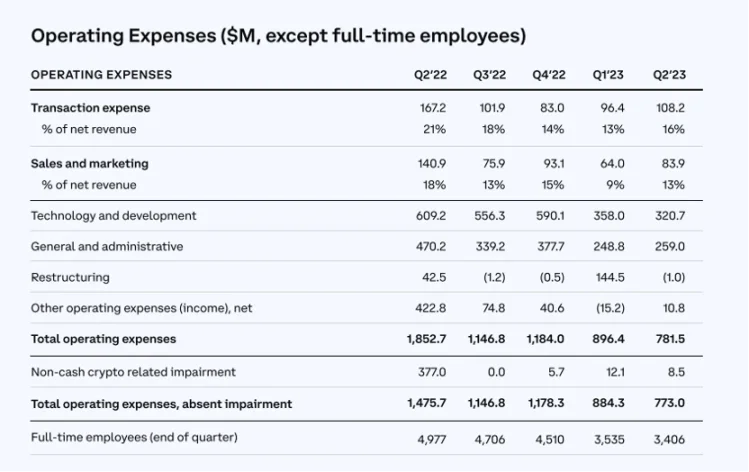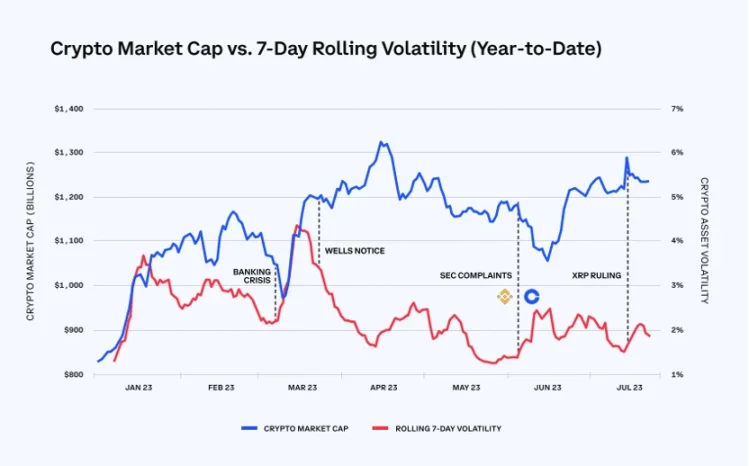Coinbase is fully embracing on-chain operations. As for the lawsuit with the SEC, "we can win."
By: jk
Financial Report Data
In the second quarter of this year, Coinbase (COIN) exceeded market expectations with reported revenue of $7.08 billion and an adjusted loss per share of $0.42, surpassing the anticipated revenue of $6.28 billion and loss per share of $0.76. However, despite the overall revenue exceeding expectations, trading revenue and volume decreased to $327 million and $92 billion, respectively, both lower than the first quarter figures. Although the company's stock price initially rose after the financial report was released, it ultimately fell by 1.4% to $89.48 and is currently at $87.31.
In terms of revenue, Coinbase's financial situation underwent significant changes in the second quarter of this year. Subscription and service revenue (including custody fees, interest income, and staking revenue) reached $3.35 billion, accounting for 51% of total net revenue, marking the first time in the company's history that non-trading revenue surpassed trading revenue. However, some key components of subscription and service business, such as interest income, showed a decline in the context of market value decrease. Of the second quarter's interest income, $151 million came from its holdings of USDC.
In the second quarter, Coinbase's institutional trading revenue was $17 million, a decrease of 24% compared to the previous quarter. Institutional trading volume was $78 billion, a 37% decrease from the first quarter. The decline in institutional trading volume was mainly due to decreased market trading volume (including market maker trading volume on the trading platform) caused by a low volatility environment. However, trading volume on Coinbase Prime continued to grow, contributing to higher average fees in the second quarter compared to the first quarter.

Coinbase's second quarter revenue data. Source: Coinbase official website
Cost-wise, Coinbase continued to focus on operating with higher costs and efficiency. Total operating expenses in the second quarter were $781 million, a 13% decrease compared to the previous quarter. Among them, recurring operating expenses—including technology development, sales and marketing, and general administrative expenses—decreased by 1% to $664 million.
Coinbase's transaction expenses in the second quarter were $108 million, a 12% increase compared to the previous quarter. The main drivers of the expense increase were the rising staking rewards paid to consumers and the increase in miner fees due to increased Ethereum network activity. Transaction expenses in the second quarter accounted for 16% of net revenue, an increase from 13% in the first quarter. This increase in proportion was due to the shift in revenue composition to blockchain rewards income and the increase in miner fees.

Coinbase's second quarter expense data. Source: Coinbase official website
In terms of trading volume, despite Coinbase's stock price rising by 160% this year, it did not change its challenges in trading volume. Its total trading revenue in the second quarter decreased by 50% to $327 million, compared to $655 million a year ago. The proportion of trading volume between retail consumers and institutions remains unbalanced. Institutional trading volume accounted for 85% of the total, at $78 billion, while retail consumers accounted for only $14 billion. Despite the rebound in cryptocurrency prices, it did not attract more traders back to the Coinbase platform, and the monthly active trading users decreased by 19% to 7.3 million in the second quarter.
Key Issues from Earnings and Analyst Conference Calls
The following are some key questions excerpted from the conference call, to which Coinbase's CEO Brian Armstrong and CFO Alesia Haas, among other company executives, provided answers.
Vice President of Investor Relations Anil Gupta: Our next question is, how does Coinbase plan to directly or indirectly generate revenue from the upcoming Base L2 platform? Will this encourage more users to leave Coinbase for on-chain operations, thereby impacting trading volume? Brian?
Co-founder and CEO Brian Armstrong: Yes, I can answer that question. First, I want to correct a misunderstanding in the question itself. So the question is, will more users leave Coinbase for on-chain operations? Coinbase is fully embracing on-chain operations. And in fact, I think this will be the easiest way to access everything you want to do on-chain. This is not new at all. It has been like this for a long time, even when Coinbase launched 10 years ago, we allowed people to send and receive transactions that would happen on-chain when you were offline from the platform.
And in recent years, we have allowed people to access decentralized exchanges, various smart contract protocols through the Coinbase wallet, and we have been making this increasingly easy in our main retail app. So just to be clear, we want Coinbase to be the easiest way to access everything on-chain. We believe on-chain is a very important part of the future of this industry. People will achieve this through Coinbase. So these are not conflicting projects.
I think the real key to this question is how we can directly and indirectly profit from Base (our Layer 2 solution). Just to give a brief introduction, which may not be fully clear to everyone, blockchain transactions are happening on so-called Layer 1. They often take longer to confirm, and the transaction fees are slightly higher, so the industry has been researching for a long time on how to make it more scalable, reduce costs, and make it easier for developers to build on so-called Layer 2.
It's like the internet transitioning from dial-up to broadband. As a company driving innovation in the industry, Coinbase has been trying to help make this happen. Building on the Optimism stack, we have launched our own Layer 2 solution called Base, which will decentralize over time. Many developers have shown interest in this, and we are doing a lot of activities around this.
So how will we make money from it? Simply put, Base will generate revenue through so-called sequencer fees. When any transaction is executed on Base, these sequencer fees can be earned, and essentially, Coinbase can run such a sequencer over time like others. Indirectly, it also helps us generate revenue because it helps us grow the market. It helps us expand the ecosystem. Again, it goes back to these internet analogies. But if we can increase the utility so much that global payments become faster and cheaper, then more and more people will use cryptocurrencies every day, and that's how it indirectly helps grow our business.
Anil Gupta: Next question. The recent enforcement actions are still the most concerning issue for many shareholders. Could you provide an update on the progress of the lawsuit with the SEC? What are the key issues? How should we view the future timeline and milestones? Paul?
Chief Legal Officer Paul Grewal: Thank you, Anil. Regarding the lawsuit with the SEC, I want to be very clear that we do believe we can win. We expect to win. But it's important to understand that our goal is not just the lawsuit, but also all of our interactions with the SEC and the entire U.S. government. Our goal is to achieve regulatory clarity, protect consumers, promote innovation, and establish clear rules of the road that everyone can understand and follow. We believe that, regardless of the outcome of any specific case, this is a way for all of us to win. That's why, while we are focused on enforcement actions, we are also focused on potential legislative and other efforts to provide the clarity I mentioned.
Now, why are we so focused on driving regulatory clarity in the U.S.? It's because in the current state of affairs, we have received very conflicting signals about the law, especially considering that these laws were all enacted before the internet. Take, for example, the conflicting statements from the SEC chairman and the CFTC chairman on whether Ethereum is a security. Or consider the significant differences in the SEC chairman's position over the past two years on whether regulatory authority applies to cryptocurrency exchanges like Coinbase. Therefore, in any specific case, the result we ultimately define as a victory is regulatory clarity…
In fact, tomorrow, in our case in the Southern District of New York, we will be asking the court to dismiss the entire case. We will submit a brief statement outlining all the arguments we present to the court, and we expect to complete the submission by the end of October for consideration. We are confident in the arguments we are presenting to the court. We certainly appreciate the opportunity the court has given us to be heard early in the case, as we have been striving for clarity for a long time.
Bank of America Jason Kupferberg: Your growth in staking is really impressive, and I'm curious about this. What trends are you seeing in adoption? I guess it's mostly Ethereum, right? If you could provide us with more information on this, that would be great.
Chief Financial Officer Alesia Haas: We have seen good adoption in staking. In the second quarter, one exciting thing we saw after the Shapella upgrade, when customers could truly stake assets on Ethereum, was the widespread adoption by our institutional clients. It's clear that a major barrier for them to participate in staking was the lack of liquidity. So, we saw rapid adoption of these balances. We shared that by the end of the second quarter, our institutional clients had staked about $2 billion worth of Ethereum. We also saw stable growth in quarterly staking balances.
One point I want to comment on is that every chain is a different story. So, each chain's investors first want to own that asset, and then once they own that asset, they will decide whether to stake their assets. So, this will depend on the growth and interest of each different proof-of-stake network. But we do see, especially on the institutional side, Ethereum is driving the growth.
KBW Kyle Voigt: Perhaps we can revisit the issue of retail rates. The comments in the first quarter indicated changes in rates during that period. I believe this means that the first quarter cannot represent the operating rate of simple trading fees. So, I understand that most of the retail rates are related to the mix. But I also want to know, can you quantify how much of the increase in retail fees from the first quarter to the second quarter is due to the impact of the rate increase implemented in the previous quarter?
Chief Financial Officer Alesia Haas: So we do internally consider and attribute it, but the vast majority of the impact is generated from the mix. This impact is much greater than any other changes in this quarter.
Kyle Voigt: It looks like the fiat balances of clients decreased by $1.5 billion this quarter. I'm curious about what drove this quarter-over-quarter change. Also, did the Coinbase platform experience net customer inflows or outflows in the second quarter?
Chief Financial Officer Alesia Haas: Specifically regarding client fiat balances, I need to review and remind everyone what happened in the first quarter. In the first quarter, we actually saw fiat inflows due to the banking crisis. These fiat inflows were mainly concentrated in a few institutional clients. So, large, bulk deposits came in at the end of the first quarter. When people thought it would be safer to move fiat from some challenged banks to Coinbase, it created a chase for quality assets. As we saw the banking industry stabilize, these funds flowed out in the second quarter.
Overall, if I expand from the first quarter to the second quarter, fiat balances often track overall market activity. So, as we saw lower volatility and decreased trading volume, we naturally saw a decrease in fiat on the platform. Our fiat balances at the end of the second quarter are somewhat similar to our fiat balances in other periods of low volatility and low trading volume. Therefore, I think we should consider the second quarter as slightly more normal, while the first quarter appeared higher due to the overall events in the banking market.
Key Events and Summary of Coinbase's Second Quarter
In terms of the timeline, the major events Coinbase experienced in the second quarter mainly revolved around the SEC's lawsuit, so the underperformance in data was also expected. The impact of events such as the U.S. Silicon Valley banking crisis and the Wells notice all occurred in the first quarter, while the XRP ruling that led to the significant increase in Coinbase's stock price happened in July, and its impact on Coinbase's revenue will be reflected in the third quarter. Therefore, it can be observed that the outlook data for Coinbase's third quarter is better.

Crypto market events, total market value, and weekly volatility correlation. Source: Coinbase official website
Overall, although Coinbase's overall financial performance in the second quarter exceeded market expectations, the decline in trading revenue and volume reflects the impact of reduced cryptocurrency market volatility. However, the company's subscription and service revenue performed strongly, surpassing trading revenue for the first time, demonstrating Coinbase's diversification of its business model to adapt to market changes. For institutional clients, the decline in trading volume was mainly due to reduced market trading volume. In terms of operating expenses, Coinbase achieved a decrease compared to the previous quarter and continues to focus on cost and efficiency improvements. Looking ahead, Coinbase will continue to adjust its business strategy to address the challenges and opportunities in the cryptocurrency market.
免责声明:本文章仅代表作者个人观点,不代表本平台的立场和观点。本文章仅供信息分享,不构成对任何人的任何投资建议。用户与作者之间的任何争议,与本平台无关。如网页中刊载的文章或图片涉及侵权,请提供相关的权利证明和身份证明发送邮件到support@aicoin.com,本平台相关工作人员将会进行核查。




